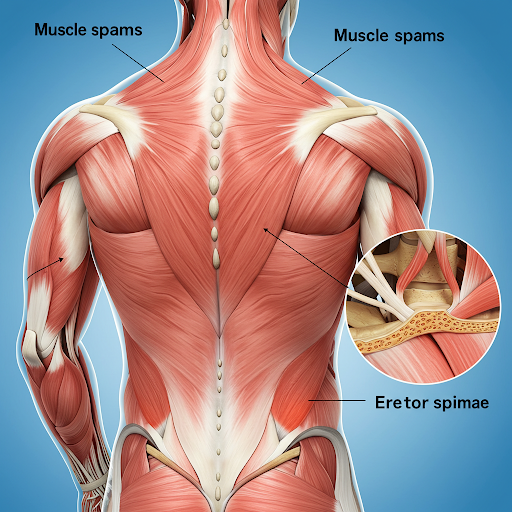Your body speaks—are you listening?
A sudden, sharp back spasm can feel like it came out of nowhere—but more often than not, it’s your body’s way of waving a red flag. Your back might be telling you to avoid a certain activity, or it could be warning of a more serious underlying issue in your spine.
A back muscle spasm is an involuntary contraction of one or more muscles in your back. Think of it as your muscles suddenly seizing up, becoming tight and painful. These spasms can range in intensity from a mild twitch to severe, locking pain that makes movement nearly impossible.
This intricate area is supported by the spinal column, a series of vertebrae that protect the delicate spinal cord and provide structural support. Numerous muscles, including large superficial muscles like the latissimus dorsi and trapezius, and deeper muscles such as the erector spinae, work together to enable movement and stability. Ligaments connect the vertebrae, while tendons attach muscles to bone. When any of these structures are stressed or injured, the surrounding muscles may spasm as a protective response.
Decoding the Signals: What Your Back Spasm Might Indicate
Decoding the Signals: What Your Back Spasm Might Indicate
While a back spasm itself isn’t usually a primary injury, it’s often a symptom of an underlying issue. Here are some common messages your back might be sending through a spasm:
- Muscle Strain or Ligament Sprain: This is one of the most frequent culprits. Overstretching, lifting heavy objects incorrectly, sudden awkward movements, or even prolonged poor posture can strain the muscles or sprain the ligaments in your back. The spasm acts as a protective mechanism, trying to immobilize the injured area to prevent further damage.
- Dehydration and Electrolyte Imbalance: Muscles need proper hydration and electrolytes like potassium, calcium, and magnesium to function correctly. Dehydration or an imbalance can make your muscles more prone to cramping and spasms.
- Nerve Irritation or Compression: Nerves in your back can become irritated or compressed due to various reasons, such as a herniated disc, spinal stenosis, or sciatica. This irritation can trigger muscle spasms as the surrounding muscles try to stabilize the area and protect the nerve.
- Poor Posture: Slouching or maintaining awkward postures for extended periods can put undue stress on your back muscles, leading to fatigue and eventually, spasms.
- Weak Core Muscles: Your core muscles (abdominal and lower back muscles) play a vital role in supporting your spine. If these muscles are weak, your back muscles have to work harder to stabilize your body, making them more susceptible to strain and spasms.
- Underlying Spinal Conditions: In some cases, recurrent or chronic back spasms can be a symptom of underlying spinal conditions like arthritis, degenerative disc disease, or scoliosis.
- Stress and Tension: Emotional stress can manifest physically as muscle tension throughout the body, including the back. This chronic tension can sometimes trigger spasms.
Don Kelly Physiotherapy and Acupuncture: Your Path to Relief in Limerick and Charleville
Don Kelly Physiotherapy and Acupuncture: Your Path to Relief in Limerick and Charleville
Our comprehensive approach may include:
- Thorough Assessment: We’ll take a detailed medical history and conduct a physical examination to understand your specific situation, identify the potential triggers for your spasms, and rule out any serious underlying conditions.
- Manual Therapy: Our experienced physiotherapists utilize hands-on techniques such as massage, mobilization, and manipulation to release muscle tension, improve joint mobility, and reduce pain. This can provide immediate relief from the spasm.
- Therapeutic Exercise: We’ll design a personalized exercise program to strengthen your core muscles, improve flexibility, and correct any postural imbalances that may be contributing to your back spasms.
- Acupuncture: As part of our holistic approach, acupuncture can be used to reduce pain, inflammation, and muscle tension by stimulating specific points on the body. This can be particularly effective in managing chronic pain associated with back issues.
- Dry Needling: This is another effective technique our skilled physiotherapists may utilize. Dry needling involves inserting thin, sterile needles into specific trigger points within tight and spasming muscles. This can help to release tension, reduce pain, and improve muscle function, offering significant relief from back spasms and contributing to the management of chronic pain. It targets the neuromuscular system to promote healing and restore normal muscle tone.
- Postural Education and Ergonomic Advice: We’ll educate you on proper posture and body mechanics to help you avoid future strain and prevent the recurrence of back spasms. We can also provide advice on optimizing your workstation and daily activities.
Don't Let Back Spasms Control Your Life
If you’re tired of the sudden, painful grip of back spasms, Don Kelly Physiotherapy and Acupuncture in Limerick and Charleville is here to help. Contact us today to schedule an appointment and take the first step towards a pain-free and more active life. We are your trusted partners in achieving long-term relief and improved well-being.


